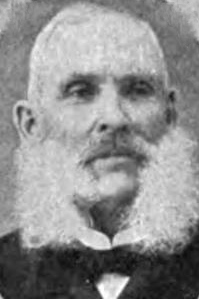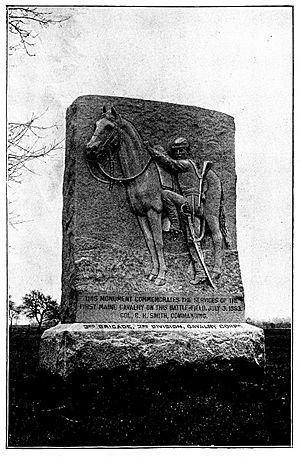Edward Parsons Tobie Jr. facts for kids
Quick facts for kids
Edward Parsons Tobie Jr.
|
|
|---|---|

Edward P. Tobie Jr., c. 1900
|
|
| Born | March 19, 1838 Lewiston, Maine |
| Died | January 21, 1900 (aged 61) Rhode Island |
| Allegiance | |
| Service/ |
|
| Rank | Sergeant-Major |
| Unit | 1st Maine Volunteer Cavalry |
| Battles/wars | American Civil War:
|
| Awards | |
Edward Parsons Tobie Jr. (born March 19, 1838 – died January 21, 1900) was a brave soldier from the United States. He earned the nation's highest award for courage in battle, the U.S. Medal of Honor. He fought for the Union Army during the American Civil War.
Tobie was a sergeant-major with the 1st Maine Volunteer Cavalry. He was badly hurt in two battles in April 1865. These were the Battle of Sailor's Creek and a fight near Farmville. Even though he was wounded, he chose to stay with his army unit. He took over the duties of another officer who had been killed. His actions helped his regiment, even at the important Appomattox.
Contents
Early Life and Family
Edward Parsons Tobie Jr. was born on March 19, 1838, in Lewiston, Maine. His father, Edward Parsons Tobie Sr., was against slavery. He worked as a wool carder and later became the town clerk of Lewiston for many years.
Edward Sr. was also a deacon at his church. He helped people who had escaped slavery find freedom in Canada. Edward Jr. grew up with his siblings: Sarah, Mary, Joseph, and Laroy/Leroy.
Serving in the Civil War
Edward P. Tobie Jr. joined the army during the Civil War. He started as a sergeant in Company G of the 1st Maine Volunteer Cavalry. He took part in many major battles of the war.
In 1862, he fought in battles like First Battle of Winchester, Battle of Cedar Mountain, and Second Battle of Bull Run. He also saw action at Battle of Antietam and Battle of Fredericksburg.
The fighting continued in 1863 with Stoneman's Raid. During the Battle of Brandy Station, he was wounded and captured. He later fought in the famous Battle of Gettysburg and the Battle of Mine Run.
In 1864, Tobie was part of battles such as Battle of Todd's Tavern, Battle of Cold Harbor, and Battle of Trevilian Station. He also fought at Deep Bottom I and Second Battle of Ream's Station. On December 12, 1864, he was promoted to sergeant-major.
Bravery and the Medal of Honor
In the spring of 1865, Edward Tobie Jr. showed incredible bravery. This led to him receiving the Medal of Honor. He was seriously wounded on April 6, 1865, during the Battle of Sailor's Creek in Virginia. The very next day, he was wounded again near Farmville.
Despite his injuries, Tobie refused to go to the hospital. He chose to stay with his regiment. He took on the duties of the regiment's adjutant, who had recently died in battle. His important work included helping at Appomattox.
His bravery was also noted in a special report by his commanding officer. On May 8, 1865, Tobie was made a second lieutenant. When the war ended, he returned home with his regiment in August 1865.
Life After the War
After leaving the military, Tobie went back to New England. On September 14, 1870, he and his wife, Adeline (Phipps) Tobie, had a son named Edward. They lived in Providence, Rhode Island. There, Tobie worked as an assistant editor for the Providence Journal newspaper.
Later, Tobie became the historian for his old Civil War regiment. The regiment had formed a group called the First Maine Cavalry Association. He was asked to research and write the history of their regiment. In 1887, he published a book called History of the First Maine Cavalry 1861-1865.
In 1889, he wrote a poem and a short history about the 1st Maine Cavalry. This was to celebrate a monument being placed for his regiment at the Gettysburg National Battlefield. He read his poem and history at the dedication ceremony on October 3, 1889.
In 1881, he was put in charge of the Providence Journal's office in Pawtucket, Rhode Island. He held this job for nearly 20 years.
Later Years and Passing
Edward P. Tobie Jr.'s wife, Addie, passed away in 1891. Edward himself became sick. He died in Pawtucket, Rhode Island, on January 21, 1900. He was buried next to his wife at Swan Point Cemetery in Providence.
See also


